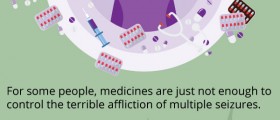
Epilepsy Effects on Life
According to experts, an epileptic seizure is a clinical event which occurs due to an abnormal and excessive neuronal discharge. In the majority of patients the clinical symptoms are paroxysmal. Some of these symptoms are impaired consciousness and motor, sensory, autonomic or even psychic events sensed either by the subject or witnessed by an observer.
Epilepsy almost always occurs in situations where there are more than two epileptic seizures which happened without being provoked by any identifiable cause. In order for the condition to be suspected of, these two attacks need to develop more than 24 hours apart. Experts have classified seizures into two categories, cryptogenic and symptomatic. The etiology of seizures remains unknown and the disorder is not in any way connected with a previous central nervous system insult when a patient with a cryptogenic seizure is considered. On the other hand, the situation with a symptomatic seizure is different and seizures occur due to a previously known disorder of the central nervous system. This type of seizures is connected with a previous insult to the central nervous system which in essence increases the risk of developing epilepsy.
When causes of epilepsy are considered, these may vary a lot. Even a combination of several factors can be a powerful contributor to seizures. Some of the most common causes include prenatal, perinatal or postnatal complications of pregnancy and delivery, febrile seizure, cerebrovascular diseases like cerebral infraction, cerebral hemorrhage and venous thrombosis for instance, trauma to the head, especially when loss of consciousness and posttraumatic amnesia last for more than half an hour as well and certain infections of the central nervous system like meningitis and encephalitis. Apart from the mentioned, there are other causes which include neurodegenerative diseases, autoimmune diseases, brain neoplasm, genetic diseases, intoxication of different type, drug withdrawal, alcohol withdrawal and metabolic disorders like uremia, hypocalcemia, hypoglycemia and hyponatremia. Children who are younger than 16 years of age have twice as much chance of recurrent seizures than those who are aged between 16 and 60 years of age. Once seizures occur, the attacks usually repeat and the condition basically lasts for the rest of the person's life.
A person who is diagnosed with epilepsy has a lot more chances of suffering from sudden death. The situation when this happens is medically called SUDEP or sudden unexplained death in epilepsy. The actual cause that leads to SUDEP remains unknown. However, medical experts are sure that the risk of SUDEP is several times higher in those who suffer from epilepsy than those who do not. The risk of SUDEP also depends a lot on the severity of the epilepsy. Furthermore, those diagnosed with epilepsy are at higher risk of injuries in general, such as burns and physical injuries. This is mainly because seizures cannot be predicted and a lot of patients are either unable or unwilling to take precautions against physical injuries. These are only some of the reasons why proper epilepsy treatment is essential.
How Common can they Become
In comparison to certain other neurological conditions such as migraines for example, epilepsy is not considered to be a frequent disease. The data shows that no more than 1% of the entire population in the United States is diagnosed with epilepsy. The risk of developing epilepsy at some time in life is a bit higher and the condition occurs in about 5% of all people. The incidence of epilepsy is only high in individuals who are in their first few years of life. There are certain risk factors/conditions which increase the risk of development of childhood seizures and the most usually ones are infection of the central nervous system, mental retardation and cerebral palsy.
There are a lot of genetic types of epilepsy which are seen in the early childhood. The situation is somewhat different in later stages of life when idiopathic seizures predominate. Finally, several medical conditions are strongly associated with epilepsy affecting adolescents and adults. These include migraines, severe head injury and an infection of the central nervous system.

















Your thoughts on this
Loading...